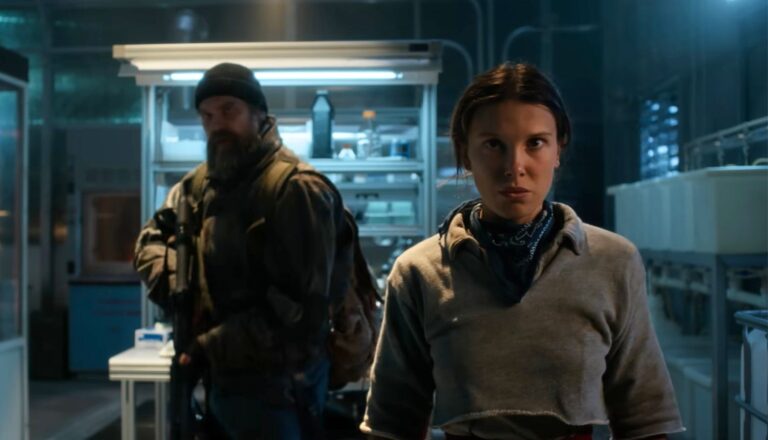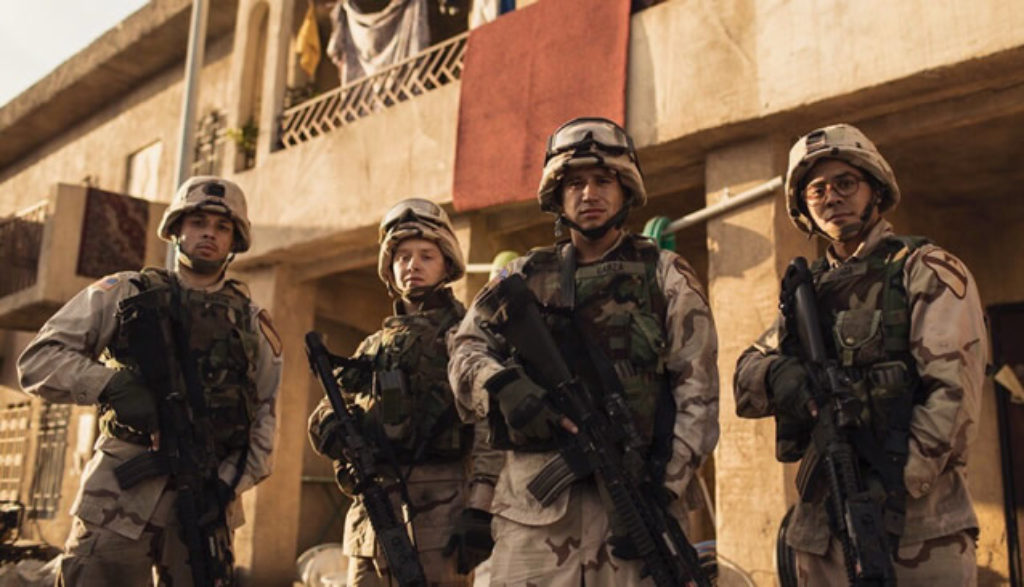
Stranger Things
The newest season of Netflix’s Stranger Things continues to blend ’80s nostalgia with ever-darker spiritual content and horrific violence.

They came in peace. Really.
Not everyone in Sadr City, Iraq, believed that in the spring of 2004. Yes, the Americans had helped free the country from Saddam Hussein’s tyrany. He’d been gone for almost a year by then, yet the American army was still here—rumbling through the streets in its armored vehicles, rousting civilians and generally disrupting any possibility of anything returning to normal. To some Iraqis, these American liberators looked more like conquerors—oppressors here to take their oil, insult their religion and rob them of their newfound independence.
But for Lt. Col. Gary Volesky, there’s no question about what he’s there to do, no ambiguity. He and his men are there to keep the peace. To rebuild this little section of Iraq. To help the people there stand on their own and to leave behind a better place than when they arrived.
Sure, not everyone’s happy with the work they’re doing here. Sometimes, imams rail against the Americans in their Friday sermons. But to Volesky’s way of thinking, the only way to combat that is by making Sadr City more livable, day after day after day.
“All we can do is lead by example,” he tells one of his troops. “Every time we do something good here, it’s a beat of that drum. … People are going to see amazing things from us here.”
And so Volesky still believed April 4, 2004—Palm Sunday back in the states. In Sadr City, Iraq, the date came to be known by another name: Black Sunday.
National Geographic’s ambitious new miniseries is already spoiled: We know what happened. The Long Road Home is based on the bestselling book by ABC News correspondent Martha Raddatz, and it chronicles in sometimes brutal detail the events in Sadr City on and around April 4. Eight Americans died that day (dozens more were injured), when a previously peaceful city erupted in violence. Countless Iraqis died April 4, too, and it was only the beginning. The fight around the region lasted, in some respects, for years afterward.
But the series does something that no news broadcast or Twitter update can effectively do: It gives us a view from the ground, and from home, of some of the most challenging circumstances imaginable.
Ultimately, Volesky’s the guy in charge. A man of deep faith, he plotted the (apparently) unsuccessful efforts to win the hearts and minds of the people there. Now he must lead a battle against a rebellion he never suspected was brewing—and save as many lives as he can.
But Volesky’s not the star of the show. Every episode is told, more or less, from the perspective of one of the men or women involved in the effort: from Lt. Shane Aguero, who led his small unit into the initial ambush; to Jassim Al-Lani, the Iraqi translator who may, or may not, be working with the enemy. Each character we see—most or all of whom appear to have a real-life counterpart—feels real and fully fleshed out for us.
Which makes it all the harder when that flesh begins to bleed.
The Long Road Home has already earned a great deal of praise, in part for its realism. It’s been called “brutal,” “authentic” and “unflinching.” But even as secular reviewers suggest that all that realism helps make this series a must-see television event, it paradoxically makes it that much harder to watch, too.
Listen, the television landscape has no shortage of blood. We’ve seen it shed by the bucketful in Game of Thrones and The Walking Dead, and by the ludicrous vatful in American Horror Story.
But however involved we may become in those shows’ characters, and however realistic the directors try to make the carnage look, we know that what we’re watching is fiction.
The Long Road Home, while obviously a dramatization, looks and feels inherently different. Perhaps it’s because we know that the action we see on screen was based on real events, and that the people we watch die represent real individuals. Perhaps it’s because Nat Geo takes special care to introduce us to these characters—to their lives and their families and their friends on the front lines, who cry and grieve and rage.
And yet for as dear as life feels, it’s often treated cavalierly in Sadr City. When a young soldier kills his first man, a comrade reminds him that in Iraq, life is cheap. He recalls seeing a dead man in a car one day, “flies crawling out of his eyeballs and nostrils. Not one person cared enough to stop.”
The language is also enough to stop many would-be viewers, too. Again, Nat Geo is aiming for realism here, and the multitude of profanities are likely about what we’d hear in the barracks and the battlefield. But that doesn’t make them any easier to hear.
But for all those real negatives, The Long Road Home offers a more rewarding sort of realism, too. These soldiers aren’t perfect. Many are deeply flawed. And yet we see in them a certain purpose and idealism that, I think, would ring true for many a serviceman and woman watching. The show also gives us a glimpse of something even more rare: an indication how important faith is to many of our characters. I don’t know if I’ve seen more sincere prayers in any show as I saw in The Long Road Home’s first two hours.
National Geographic’s miniseries can be messy, brutal and grim. But for some viewers, it may offer value in the messy truths it gives.
(Editor’s Note: Plugged In is rarely able to watch every episode of a given series for review. As such, there’s always a chance that you might see a problem that we didn’t. If you notice content that you feel should be included in our review, send us an email at letters@pluggedin.com, or contact us via Facebook or Instagram, and be sure to let us know the episode number, title and season so that we can check it out.)
Lt. Shane Aguero commands a unit of soldiers newly deployed as peacekeepers to Sadr City, Iraq. It’s a relatively safe assignment: Sadr City is one of Iraq’s success stories in early 2004. But all that changes when some Iraqis attack in a well-organized uprising, ambushing Aguero’s unit on just its fourth day in-country.
One man gets killed in the ambush, but he doesn’t die immediately. We see a bloody hole in his gut and glimpse his blood-covered body. When an apparatus designed to facilitate breathing is stuck in his mouth and CPR is administered, blood pulses upwards through it. When he dies, Aguero—a Catholic who admits having not attended Mass in a while—says a prayer over the body. “I pray that You may take him into Your arms, dear Lord,” he says. “Allow him entry into Your paradise that his soul may rest in peace.”
That’s not the only prayer we hear: Col. Volesky prays as well, and the two-part episode closes with a chaplain offering a Christian prayer. Bibles are toted. Crosses, rosaries and good luck charms are worn. We see women wearing full-length hijabs, and a tense confrontation takes place outside a mosque. Back at home, spouses and children attend a Palm Sunday service, where we hear more prayers. A departing soldier and his family sit at a table and say grace.
Elsewhere, we flash-forward to a scene filled with injured, groaning and screaming men. Blood and bandages are everywhere. The camera shows men with missing limbs. Iraqis also are shot and killed. One Iraqi lies lifeless in the street, as his shooter stares at the body and considers what he’s done. “They made me into a killer,” the boy says. “I hope they’re happy.” A boy with a grotesquely injured foot (we see a big chunk of flesh missing from the bloody injury) hops over to some American soldiers to get help. We hear lots of gunfire and see plenty of fire and explosions.
We hear about 15 s-words. Other profanities include “a–,” “b–ch,” “d–n,” “h—,” “p—ies” and “p-ss.” A joke relies on the last name “Fokker.” God’s name is misused three times.
Soldiers clean out an open sewer: One of them, overwhelmed by the smell, vomits. Several soldiers look forward to a Dungeons and Dragons game. A new soldier freaks out when one of his pals puts a (harmless) whip scorpion on him. A couple of soldiers smoke cigarettes.

Paul Asay has been part of the Plugged In staff since 2007, watching and reviewing roughly 15 quintillion movies and television shows. He’s written for a number of other publications, too, including Time, The Washington Post and Christianity Today. The author of several books, Paul loves to find spirituality in unexpected places, including popular entertainment, and he loves all things superhero. His vices include James Bond films, Mountain Dew and terrible B-grade movies. He’s married, has two children and a neurotic dog, runs marathons on occasion and hopes to someday own his own tuxedo. Feel free to follow him on Twitter @AsayPaul.

The newest season of Netflix’s Stranger Things continues to blend ’80s nostalgia with ever-darker spiritual content and horrific violence.

After a seven-year hiatus, the wacky town of Elmore is back, as Gumball and his family embark on even more weird adventures.

The Amazing Digital Circus places its digitized humans under the terrorism of a maniacal AI ringmaster and his chaotic adventures.

The self-centered hedonistic approach of every character in Emily in Paris only seems to increase, and the praises for it are doubled.